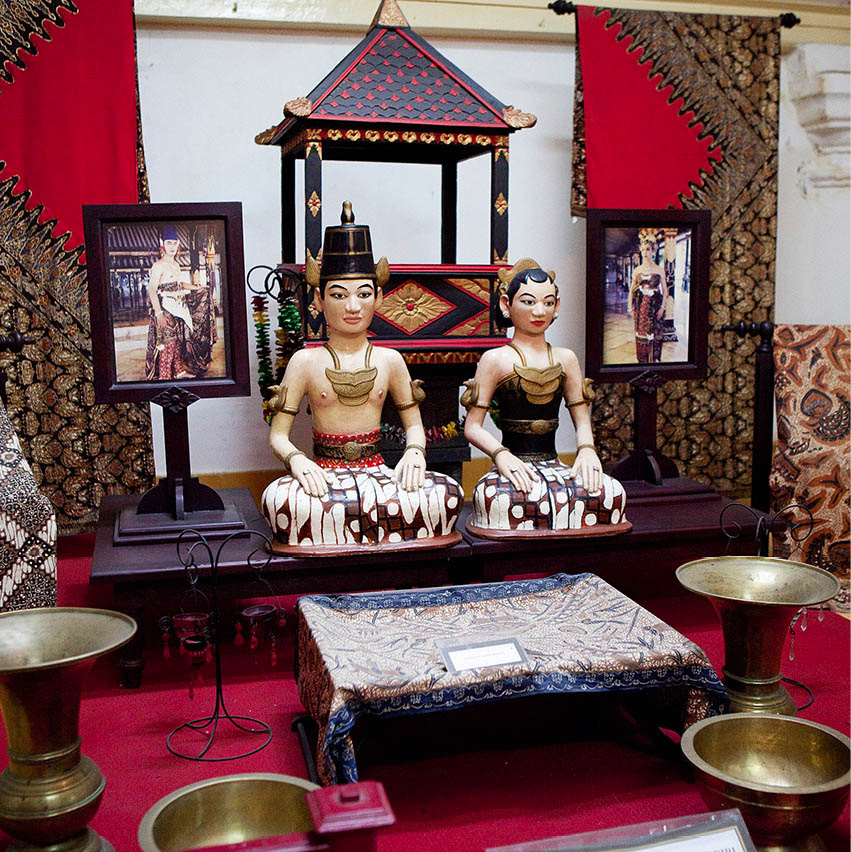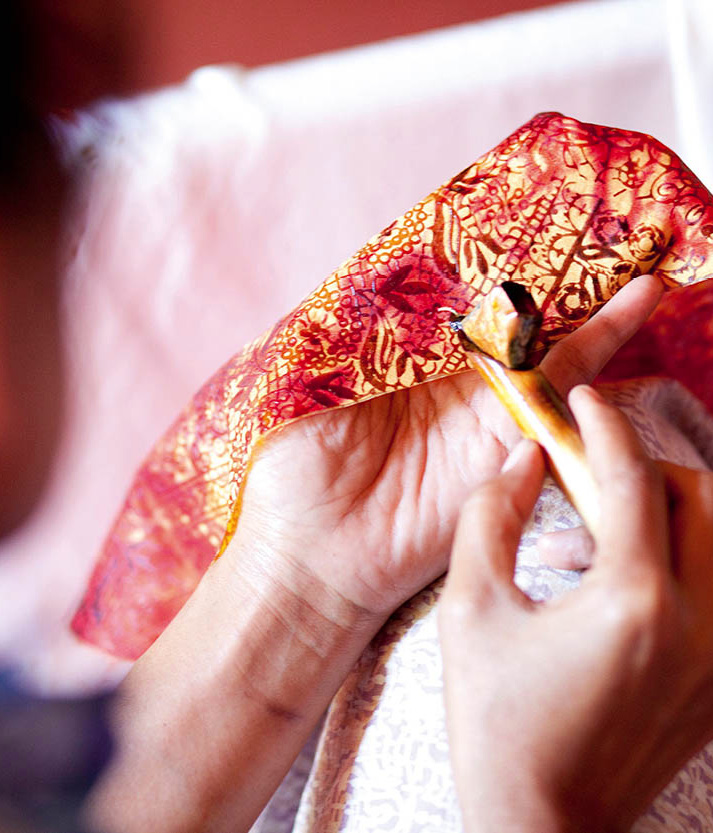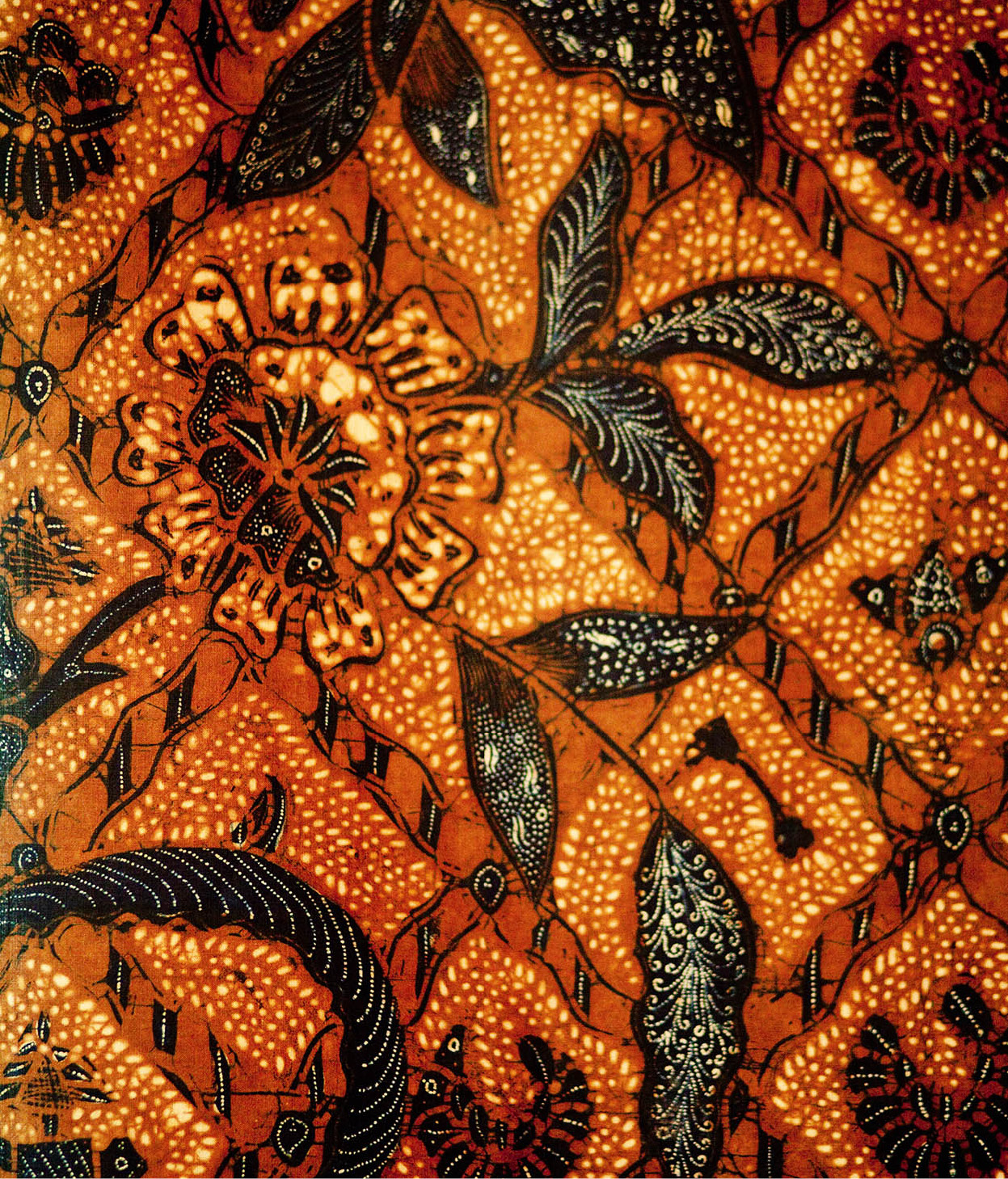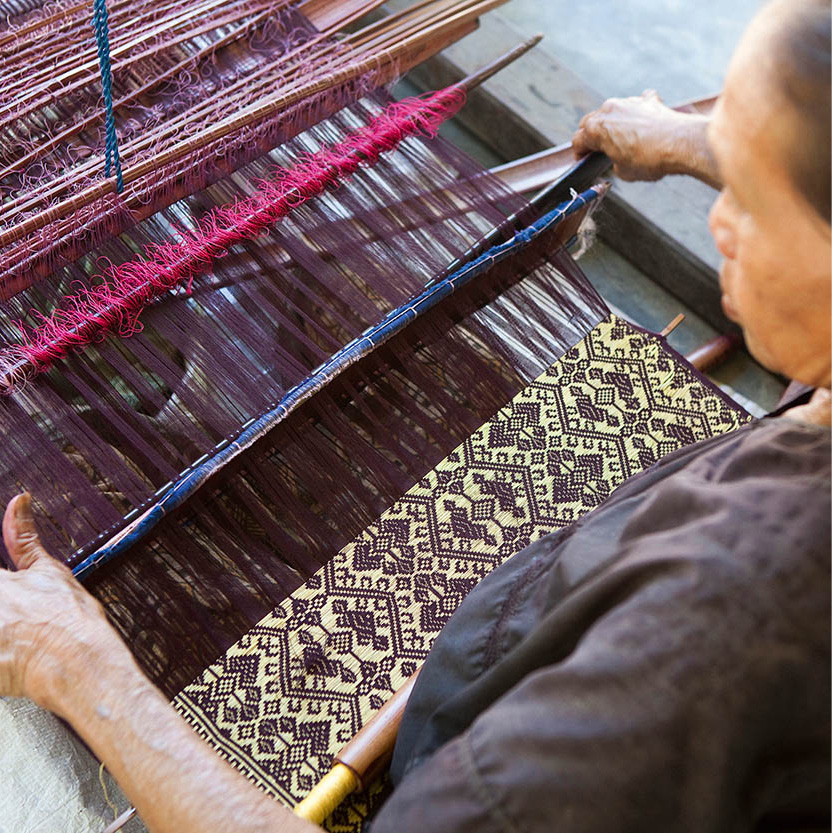Indonesia is one of the world’s greatest producers of fine traditional textiles. One of the oldest expressions of traditional art, handmade cloth is a vital component of Indonesian culture. Textiles are not only mere articles of clothing, but are also important to the cultural heritage of the country, as spiritually charged talismans, and symbols of wealth and status.
To understand the true value and meaning of Indonesian textiles, we have to examine their cultural context and the belief systems of the people who produce them. The materials, colours and motifs, along with rituals for their creation and use, all serve as powerful messages that convey wealth, social status, religious belief, the marriage contract and a connection to the spirit world.
Traditional textiles are works of art created by craftswomen who incorporate a medley of technical skills: weaving, dyeing and embroidery using any choice of natural fibres, including bark, cotton and silk. Some are embellished with shells, beads and gold or silver threads, but use methods and techniques that have changed very little over centuries.

Inside Yogyakarta’s Batik Museum.
Corrie Wingate/Apa Publications
Symbol of birth
The process of manufacturing textiles is interwoven with taboos that define gender-role responsibilities to ensure the harmony of the community. Spinning, dyeing and the weaving of yarn are regarded as symbolic of the process of creation, and of human birth in particular. Weaving is generally an exclusively female activity. Men are permitted to participate only in the dyeing of certain colours of the thread, analogous with their role in human conception. The dyeing process is carried out in the utmost privacy, behind partitions set up around the work area. Pregnant, menstruating or sick women are excluded from this work.
A traditional cloth produced with natural dyes once took many years to complete. The main natural dyes used in traditional textiles are indigo (Indigofera tinctoria), mengkudu (Morinda citrifolia), soga (a brown dye from root and bark) and mud dyes. Today, because of time and economic constraints, many textiles are coloured by chemical dyes.
In some areas, the mounting of threads on the loom is done on an auspicious day, otherwise the threads would break and bring bad luck. In several coastal villages, this means a full moon and a high tide. If a death occurs in the village, weaving stops at once to prevent the spirit of the departed from exacting vengeance by bringing sickness upon the weaver and causing the threads to lose their strength. Finished products are usually sanctified by metaphysical and psychological associations, and therefore regarded as powerful objects that can protect the weaver, cure illness, bring rain and are often necessary for life-cycle rituals.
Indigo dye
Indigo dye from Indigofera tinctoria is the most widely used natural blue dye in the world. The recipe for the dye was once a guarded secret, but today it is known across the archipelago. The dye is prepared in a vat and goes through a fermentation and oxidation process. Indigo leaves are first soaked overnight in earthenware jars of water. The leaves are then removed and lime is added, causing chemical reduction. Cotton or silk threads dyed in this vat are then hung up to oxidise. This process is repeated until the desired colour intensity is achieved and the indigo threads deemed ready to be woven.

Traditional methods of batik making, Brahama Tirta Sari Studio, Yogyakarta.
Corrie Wingate/Apa Publications
Development
Cotton and silk have been used for making cloth for the past 3,000–5,000 years. As the spice trade developed over the last two millennia, Arab, Indian and Chinese traders discovered they could obtain valuable spices in exchange for Indian cotton and silk. Indonesians in turn found they could barter their easily gathered cloves, nutmeg, peppers and aromatic woods for fine textiles from the traders.
Many of the techniques and motifs in Indonesian textiles were adapted from foreign examples. As early as the 14th century, Indian fabrics were imported on a large scale, and the Indian textile revolution extended to fabrics that were considered rare and valuable, or even magical. The single most influential cloth is the Indian patola, a double-ikat silk fabric produced in Gujarat. Widely reproduced in Indonesia, it was incorporated into the ceremonial lives of many Indonesians and formed part of the costumes of kings on several islands, including Java. As fewer patola were imported after 1800, weavers throughout Indonesia set about producing replicas. Today, the eight-pointed-flower or chabadi bhatt design is seen everywhere.
Indonesian textile decoration methods fall into three major categories: dye-resist, woven and embellished techniques. There are two dye-resist processes: the wax on cloth batik and the tie-and-dye process of warp, weft and double ikat. Warp and weft ikat are produced by the Batak (North Sumatra), in the Nusa Tenggara islands, East Java, Kalimantan and South Sulawesi. Weft ikat is produced in Bali, West Lombok, East Java, Palembang, Sumatra and in South Sulawesi, while double ikat is only produced in Bali. Woven decoration includes supplementary warp and weft, tapestry, tablet-weaving, embroidery, appliqué, beadwork and shellwork. Embellished techniques include supplementary weft such as songkets, supplementary warp and warp-wrapping.
Batik
Batik is Indonesia’s renowned textile art, especially Javanese batik, which is regarded as the world’s finest. In the technique, dye-resist wax is applied to the cloth to prevent the dye from penetrating certain areas, thus resulting in a pattern in the negative. Finely detailed batik tulis (‘written’ design) is made possible with a tool called a canting. The canting, a small copper cup with a spout through which melted wax flows, is mounted on a handle and is wielded like a pen, allowing the artist to execute designs.
The first step is to draw a design on a piece of silk or cotton cloth. Areas not to be coloured in the first dyeing are covered with wax. This process alone can take hundreds of hours. The cloth is then immersed in dye and dried off. With natural dyes, repeated immersions and dryings are necessary, and a single dyeing can take months to complete.
For subsequent dyeings, either more wax is added to seal areas of the first dye before over-dyeing with a second colour, or the cloth has to be de-waxed and waxed again. Wax is removed by boiling in water or by being scraped off. Dyeing and drying follow, and the process is repeated as many times as there are number of colours on the cloth.
In Central Java, certain motifs were once reserved for the royal court, such as the parang rusak barong, a broken sword design that consists of diagonal rows of interlocking scrolls. Today, out of respect for the descendants of the royal family, many locals will choose not to wear batik printed with motifs that were originally regarded as sacred to the royal court.
Batik cap is produced with the use of a metal printing block. The cap stamps are built out of thin strips of copper and wire soldered to an open frame. The cap is dipped into heated wax before it is pressed firmly onto the cloth. The advent of batik cap revitalised the industry in the 1890s, making mass-produced cloths that were affordable to all and creating an export trade from Java to the Outer Islands. For more on batik, for more information, click here.
Ikat
Warp ikat is a traditional method of weaving in which the warp threads (on the length) of a cloth are tie-dyed prior to weaving. The process of spinning cotton threads and preparing the dyes, binding the warp threads in a pattern that will resist the dye, and then repeatedly immersing, drying and re-binding them to achieve the desired colour requires tremendous skill and patience. In the hands of a master weaver, the end result is intricate, detailed motifs executed in deep, rich colours. Weaving is done on a backstrap loom, with either discontinuous warp threads affixed to the loom’s beams or a continuous warp bent around the beams so as to create a tube of cloth. While one beam is attached to a grounded object (tree or house post), the other is secured to the weaver with the tension maintained by a strap placed around the weaver’s back as she sits on the ground. String heddles are employed to create individual sheds, and sometimes a bamboo comb is introduced to maintain the spacing of a discontinuous warp.
Lurik
References in old Javanese Hindu inscriptions (AD 851–82) mention striped and checked textiles that are today known as lurik. In Java, what remains of the lurik weaving culture is centred in Jogja, Solo and Tuban, with the most obvious examples of lurik being the traditional coats worn by the palace guards at the Yogyakarta Keraton. However, the isolated Badui of West Java still weave lurik for their daily attire, and there are a handful of weavers in Banyumas, who call their cloth kluwung. Sadly, in Kudus in the northeastern part of Java, which once had a fairly wide range of motifs, only a few remain today. On Bali, these textiles are called keling and saudan, and remain ritually important.
Each motif on lurik cloths is defined by a specific palette and organisation of stripes and each has a symbolic meaning, is considered sacred, or thought to possess magical powers. Ancient rice paste-resist patterns on lurik textiles were probably the first Javanese batiks. Lurik is thought to pre-date tie-and-dye ikat textiles, though the origin of the latter is unclear.
Hand-woven lurik disappeared from favour with the advent of mechanised fabric factories producing a wider range of designs and colours at cheaper prices, but today it is experiencing a comeback thanks to a new generation of Indonesians who have great respect for old traditions.
The most famous warp ikats are the hinggi from East Sumba. These cloths are known for their rich colours, fine details and bold, horizontal fields of stylised human and animal figures. Normally produced in pairs, one to wrap around the body and one to drape over the shoulders, they have served as valuable trade goods for centuries and were exported extensively by the Dutch in the 19th century. Hinggi textiles are used in Sumba to seal a marriage contract and in funerals; it is not uncommon to wrap the body of a nobleman or woman in as many as 100 textile pieces.
The neighbouring island, Timor, is known for its brilliantly coloured warp ikat embellished by supplementary techniques such as sotis, a float weave using contrasting colours and usually woven into small panels. There is also the complex process of buna, which resembles heavy embroidery.

Traditional batik, Brahama Tirta Sari Studio.
Corrie Wingate/Apa Publications
Another well-known warp ikat is the red, brown and white ulos ragidup (pattern of life) cloth of the Sumatran Bataks. This is presented by the father of the bride to the mother of the groom, who later presents the cloth to her daughter-in-law when she is seven months pregnant with her first child, as an ulos ni tondi or ‘soul cloth’.
Weft ikat (resist-patterning of the crosswise threads) occurs primarily in Bali and the Islamic coastal trading areas of Gresik in East Java, Palembang and elsewhere in South Sumatra. Weft ikat is usually woven on a ‘fly shuttle’ handloom.
The Palembang and Bangka weft ikat are extremely sophisticated, done on silk in rich tones of red, blue and yellow, often with supplementary gold threads in the weft. Indian, Javanese and Chinese motifs are all employed, sometimes simultaneously.
Today, weft ikat is a thriving cottage industry, with great amounts of cloth woven in bright colours and floral or geometric designs. A special weft ikat textile, kain limar, woven with gold threads, is worn by boys on the day of circumcision, a special rite among Muslim Palembang and Sumatran families.
Geringsing
The rare double ikat, known as geringsing, is made in Tenganan, a small village in East Bali, one of only three places in the world to produce this labour-intensive textile. The other two places are India and Japan. It can take several years just to complete a single geringsing piece. Both warp and weft threads are tied and dyed, then woven to produce an integrated motif on the finished fabric. Red being the predominant colour in most geringsing, the background is indigo overdyed with red to produce a midnight black.
Considered by the Balinese to be sacred, geringsing is used in many important ceremonies throughout the island, including tooth filings. In Tenganan, wearers of the cloth are thought to be protected from evil and illness, as geringsing means ‘without sickness’.
Geringsing is said to have protective powers. Kings once presented geringsing garments to warriors prior to battle.

Songket weaving at Sukarara weaving village, Lombok.
Corrie Wingate/Apa Publications
Songket
Songket – cloth of gold or silver – is an ornately brocaded textile that has gold or silver threads worked into it. On a silk or cotton base, ‘floating’ metallic weft threads are woven in to create a raised pattern that almost resembles embroidery. Areas with the best songket are Bali and Palembang, and those produced by the Minangkabau are sought after as well.
Palembang songket features gold threads woven onto bright red silk to form a fine geometrical pattern that often covers the entire cloth, while the Minangkabau’s silver-threaded songket has a background of wine-red or black silk. Wearing songket became a sign of physical and spiritual blessings.
Once a cloth favoured by the royal class, songket (also known as tanuk), is worn today in a formal headdress by the Minangkabau women of West Sumatra. It serves as a display of wealth and the way it is folded also indicates which village the wearer is from.
The sacred maa cloths of the South Sulawesi Torajans are kept in special baskets and are essential for major rituals. Some maa are thought to be effective vessels for fertility spirits, and opening a powerful cloth is said to bring immediate rainfall.
Bark cloth
Bark cloths found among upland tribes in Kalimantan, Sulawesi and Papua display a high degree of artistry and techniques that date to the prehistoric era.
The Torajans boil and ferment the inner bark of Pandanus, mulberry or other trees before beating – with special wooden and stone mallets – the resultant pulp into extremely soft and pliable sheets. This cloth (fuya) is then dyed, painted or stamped using natural pigments.
Certain tribes in Kalimantan, Flores, Sulawesi and Timor produce warrior tunics from fibres by twining them, a simple process in which two weft fibres are alternately wrapped above and below a passive warp.